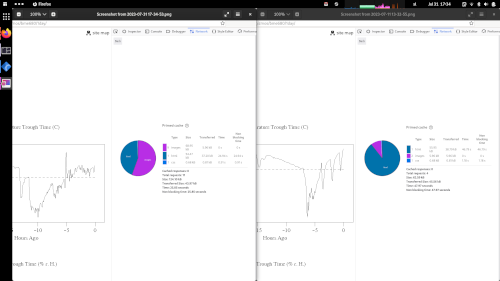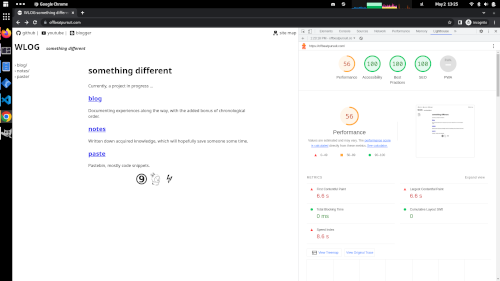Well, it’s more of a reminder than a lesson.
It is more important what you optimize than how much you optimize.
It turns out, that for all the overclocking and tweaking of the abused first generation Raspberry Pi, the best performance increase you can get:
Is to not read everything all of the time from the SD card:
Some quality of life improvements for YOU three (you know who you are) that have found and use this page.
Firstly, some improvements to RSS functionality of werc. Now, the built-in blagh blog or the additional barf app have a nice feature that generates an RSS feed list by calling index.rss on the content folder. Something that I think would be cool for any folder. Maybe you’re interested in just part of the site or would like an RSS feed update when new content is posted, but is not a blog.
Well, this feature is no longer missing! Introducing the rrsfy werc app, which allows for RSS feed creation on any configured folder through the index.rss “interface”.
This brings the available feeds for this site to:
- blog https://offbeatpursuit.com/blog/index.rss
- paste https://offbeatpursuit.com/paste/index.rss
- notes https://offbeatpursuit.com/notes/index.rss
And while we’re here, since the code for the rssfy is based on the existing apps, a fix for the creation date if posts for barf.
To improve the blog, let’s make an index of tags. More in the web notes
The barf comes with some scripts (some work, some are author specific), and one of them (gt) generates a list of posts and associated tags (which makes clicking on the tag and displaying associated posts work).
Now, let’s add some custom magic to generate a header with clickable links. And there we go.
Secondly, there are also some CSS tweaks to spruce up the look.
How all this affects the look is left as “homework” for the reader to figure out.
A few changes and we have the basic site up in a pretty decent shape.
Sadly, can’t do anything more for the performance. It is what it is, for a (let’s be generous) “server” running a niche OS on a first generation Raspberry Pi.
To get it this far:
create pub and lib directories in _werc directory of the site
generate all other possible versions of favicon icons (ios, android, …), add them somewhere unobtrusive (eg. _werc/pub/) and create a file headers.inc in ___werc/lib__ and add the definitions:
<link rel="apple-touch-icon" sizes="180x180" href="/_werc/pub/apple-touch-icon.png"> <link rel="icon" type="image/png" sizes="32x32" href="/_werc/pub/favicon-32x32.png"> <link rel="icon" type="image/png" sizes="16x16" href="/_werc/pub/favicon-16x16.png"> <link rel="manifest" href="/_werc/pub/site.webmanifest">while editing headers.inc add the definition for device width:
<meta name="viewport" content="width=device-width, initial-scale=1">This will make the best practices score happy.
copy over headers.tpl from werc/lib to _werc/lib of the site and change
<html>to
<html lang="en">This will make the accessibility score happy.
edit your _werc/config and add meta description:
meta_description='A collection of notes on various topics.'This will make the SEO score happy.
All this could be done in headers.tpl, but the system is configurable, so let’s use the options.
To make the barf blog plugin for werc work as a subfolder, we need to patch it up to correctly parse the slug when it’s not attached to the domain root: diff
Now, add top_bar.inc and footer.inc to your _werc/lib to add page header and footer content.
And for custom styles, create style.css in your _werc/pub folder.
So, the time has come to scrape together a system for publishing, as we set out to do.
For the base, so far, we have a 9front installed on a first generation Raspberry Pi. For hosting, we’ll use rc-httpd web server, distributed with 9front. For content management we’ll use the Werc framework, used by other plan9 / 9front related sites, with barf plugin for blog and other nifty things.
Not to go into too many details here, since this is a learning experience and information will be improved over time (I’m sure), so notes for web are available separately.
In short, how we got this working so far:
- (optionally) a new user was created (gotta figure out administration of this thing)
- werc was installed by cloning it with hg from https://code.9front.org/hg/werc
- werc was configured by creating appropriate folders in werc/sites dir
- barf plugin was installed by cloning it with hg from https://code.9front.org/hg/barf in to werc/apps dir
- barf was configured by creating the appropriate folders and files in _werc subfolder
- rc-https was configured (/bin/service/tcp80) to run werc on request
- example files can be found in werc/bin/contrib (tcp80 & rc-httpd/select-handler) or on the werc docs
- since services in /bin/service are run as an “unprivileged” user none, with no privileges (duh) and werc needs to access to tmp files cor cache or its unhappy, configure the namespace for the service (/bin/service/tcp80.namespace) to include a “world” writable folder binded to /tmp
That got us a working set up, that we can now play around with, and do the “timey wimey” magic and “back port” some notes and posts.


